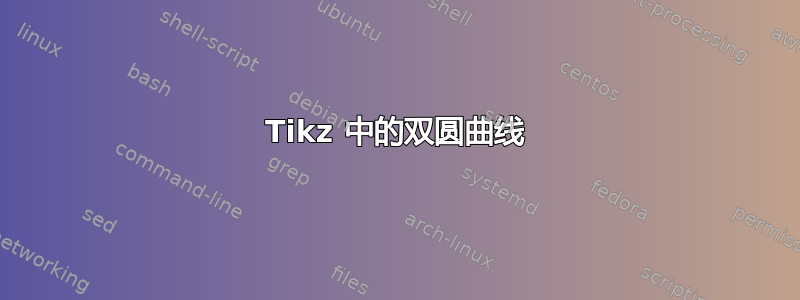
我正在尝试用 制作图表tikz,希望您能帮助我了解一些细节和技术细节。我正在尝试做类似以下的事情
:
以下是我的问题。
1) 我目前正在“逐行”绘制线条,并且不使用任何“双线”技巧。这样做的问题是,我在纸上计算坐标,由于它们的斜率不同,很难使线条之间的正交距离相同。我的意思是这当然是可行的,但我想知道是否有命令可以自动计算它。
2) 如您所见,原点周围非常丑陋,我不确定什么会好看。有什么想法可以让它看起来更漂亮吗?我希望 1) 的方法也能解决这个问题。
3) 图表的目的不是画一些线,而是将这些线划定的区域分开,这就是我选择双线方法的原因。任何为此目的提出的艺术想法也值得赞赏!
感谢您的时间,
编辑:这是一个 MWE。
\documentclass{amsart}
\usepackage{tikz}
\begin{document}
\definecolor{color1}{RGB}{134,14,156}
\definecolor{color2}{RGB}{6,138,39}
\definecolor{color3}{RGB}{12,39,156}
\definecolor{color4}{RGB}{153,0,0}
\begin{tikzpicture}[scale=0.4]
% Tau-local stuff, w = s/2
\draw [very thick, color1, rounded corners] (0.4,-6) -- (0.4,0) -- (33,7);
\node [right, color1] at (28,5.2) { $w = \frac{1}{2}s$ };
\node [color1, align=center] at (19,0) { \Large $\tau\textsf{-local region, corresponds}$ \\ \Large $\textsf{to classical homotopy groups}$ };
% Exotic Motivic, w = 3s/5 + 2
\draw [very thick, color2, rounded corners] (33, 7.4) -- (0,0.4) -- (31,16);
\node [right, color2] at (28,14) { $w = \frac{3}{5}s + 1$ };
\node [color2] at (25,8) { \Large $\textsf{exotic motivic phenomena}$ };
% Eta-local stuff, w = s
\draw [very thick, color3, rounded corners] (31,16.45) -- (0,0.85) -- (16,16);
\node [right, color3] at (16,15.5) { $w = s$ };
\node [color3] at (18.5,13) { \Large $\eta\textsf{-local region}$ };
% Vanishing region
\draw [very thick, color4, rounded corners] (-0.4,-6) -- (-0.4,1) -- (16,16.6);
\node [color4] at (-2,-3) { \scalebox{3}{$0$} };
\node [color4] at (-2,11) { \scalebox{3}{$0$} };
\node [color4] at (5,11) { \scalebox{3}{$0$} };
% grid and axes (drawn at the end so they're on top)
\draw [very thick, ->] (0,-6) -- (0,16);
\node [left= 4pt] at (0,16) { \huge $\textbf{w}$ };
\draw [very thick, ->] (-4,0) -- (33,0);
\node [below=4pt] at (33,0) { \huge $\textbf{s}$ };
\end{tikzpicture}
\end{document}
答案1
\documentclass{amsart}
\usepackage{tikz}
\begin{document}
\definecolor{color1}{RGB}{134,14,156}
\definecolor{color2}{RGB}{6,138,39}
\definecolor{color3}{RGB}{12,39,156}
\definecolor{color4}{RGB}{153,0,0}
\begin{tikzpicture}[scale=0.4,line cap=round]
% Tau-local stuff, w = s/2
\draw [very thick, color1, rounded corners] (0.4,-6) -- (0.4,0) -- (33,7);
\node [right, color1] at (28,5.2) { $w = \frac{1}{2}s$ };
\node [color1, align=center] at (19,0) { \Large $\tau\textsf{-local region, corresponds}$ \\ \Large $\textsf{to classical homotopy groups}$ };
% Exotic Motivic, w = 3s/5 + 2
\draw [very thick, color2, rounded corners=1pt] (33, 7.4) -- (0.4,0.4) -- (0.4,0.8) -- (31.7,16.45);
\node [right, color2] at (28,14) { $w = \frac{3}{5}s + 1$ };
\node [color2] at (25,8) { \Large $\textsf{exotic motivic phenomena}$ };
% Eta-local stuff, w = s
\draw [very thick, color3, rounded corners=1pt] (31,16.45) -- (0.4,1.25) -- (0.4,1.6) -- (16.6,16.45);
\node [right, color3] at (16,15.5) { $w = s$ };
\node [color3] at (18.5,13) { \Large $\eta\textsf{-local region}$ };
% Vanishing region
\draw [very thick, color4, rounded corners] (-0.4,-6) -- (-0.4,1.4) -- (16,16.45);
\node [color4] at (-2,-3) { \scalebox{3}{$0$} };
\node [color4] at (-2,11) { \scalebox{3}{$0$} };
\node [color4] at (5,11) { \scalebox{3}{$0$} };
% grid and axes (drawn at the end so they're on top)
\draw [very thick,gray, ->] (0,-6) -- (0,16.45);
\node [left= 4pt] at (0,16) { \huge $\textbf{w}$ };
\draw [very thick, gray,->] (-4,0) -- (33,0);
\node [below=4pt] at (33,0) { \huge $\textbf{s}$ };
\end{tikzpicture}
\end{document}

这是一次填充的尝试。
\documentclass{amsart}
\usepackage{tikz}
\begin{document}
\definecolor{color1}{RGB}{134,14,156}
\definecolor{color2}{RGB}{6,138,39}
\definecolor{color3}{RGB}{12,39,156}
\definecolor{color4}{RGB}{153,0,0}
\begin{tikzpicture}[scale=0.4,line cap=round]
% Tau-local stuff, w = s/2
\draw [very thick, color1, rounded corners] (0.4,-6) -- (0.4,0) -- (33,7);
\fill [color1!20] (0.4,-6) to[rounded corners] (0.4,0) -- (33,7) -- +(0,-13) -- cycle;
\node [right, color1] at (28,5.2) { $w = \frac{1}{2}s$ };
\node [color1, align=center] at (19,0) { \Large $\tau\textsf{-local region, corresponds}$ \\ \Large $\textsf{to classical homotopy groups}$ };
% Exotic Motivic, w = 3s/5 + 2
\draw [very thick, color2, rounded corners=1pt] (33, 7.4) -- (0.4,0.4) -- (0.4,0.8) -- (31.7,16.45);
\fill [color2!20] (33, 7.4) to[rounded corners=1pt] (0.4,0.4) to[rounded corners=1pt] (0.4,0.8) -- (31.7,16.45) -- (33,16.45) -- (33,7.4) -- cycle;
\node [right, color2] at (28,14) { $w = \frac{3}{5}s + 1$ };
\node [color2] at (25,8) { \Large $\textsf{exotic motivic phenomena}$ };
% Eta-local stuff, w = s
\draw [very thick, color3, rounded corners=1pt] (31,16.45) -- (0.4,1.25) -- (0.4,1.6) -- (16.6,16.45);
\fill[color3!20, rounded corners=1pt] (31,16.45) -- (0.4,1.25) -- (0.4,1.6) -- (16.6,16.45) -- cycle;
\node [right, color3] at (16,15.5) { $w = s$ };
\node [color3] at (18.5,13) { \Large $\eta\textsf{-local region}$ };
% Vanishing region
\draw [very thick, color4, rounded corners] (-0.4,-6) -- (-0.4,1.4) -- (16,16.45);
\fill [color4!20] (-4,-6) -- (-0.4,-6) to[ rounded corners] (-0.4,1.4) -- (16,16.45) -| cycle;
\node [color4] at (-2,-3) { \scalebox{3}{$0$} };
\node [color4] at (-2,11) { \scalebox{3}{$0$} };
\node [color4] at (5,11) { \scalebox{3}{$0$} };
% grid and axes (drawn at the end so they're on top)
\draw [very thick,gray, ->] (0,-6) -- (0,16.45);
\node [left= 4pt] at (0,16) { \huge $\textbf{w}$ };
\draw [very thick, gray,->] (-4,0) -- (33,0);
\node [below=4pt] at (33,0) { \huge $\textbf{s}$ };
\end{tikzpicture}
\end{document}

这是用线条做的尝试double。现在懒得加颜色了。
\documentclass{amsart}
\usepackage{tikz}
\begin{document}
\begin{tikzpicture}[scale=0.4,]
\begin{scope}
\clip (-0.4cm,-6) rectangle (15,16);
\draw[very thick,double=white,double distance=0.2cm,rounded corners=2mm] (0,-7) -- (0,2)-- (14,17);
\end{scope}
\begin{scope}
\clip (0.25cm,0) rectangle (29,16);
\draw[very thick,double=white,double distance=0.2cm] (0,0.8) -- (28,17);
\end{scope}
\begin{scope}
\clip (0.25cm,-0.3) rectangle (33,8);
\draw[very thick,double=white,double distance=0.2cm] (0,0) -- (34,7);
\end{scope}
% grid and axes (drawn at the end so they're on top)
\draw [very thick,gray!40, ->] (0,-6) -- (0,16.45);
\node [left= 4pt] at (0,16) { \huge $\textbf{w}$ };
\draw [very thick, gray!40,->] (-4,0) -- (33,0);
\node [below=4pt] at (33,0) { \huge $\textbf{s}$ };
\end{tikzpicture}
\end{document}



